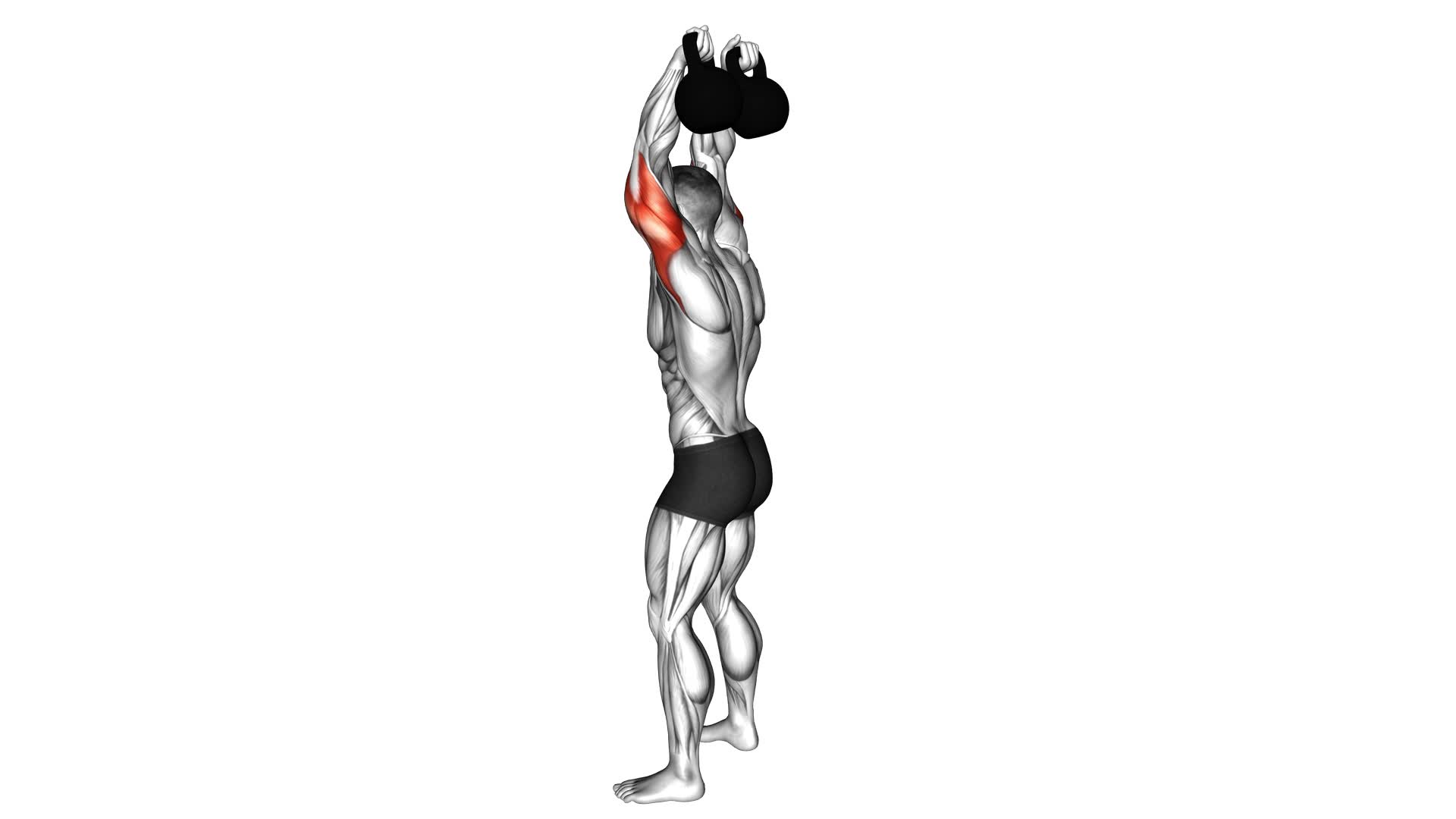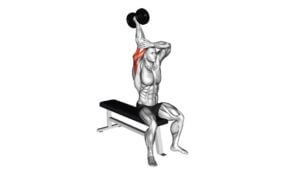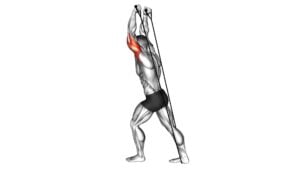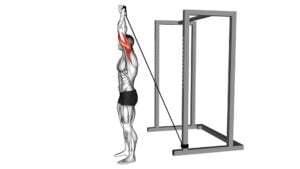Kettlebell Overhead Triceps Extension – Video Exercise Guide & Tips

Looking to tone and strengthen your triceps? The kettlebell overhead triceps extension is a fantastic exercise to add to your routine.
Watch This Exercise Video
In this video exercise guide, we'll show you the proper form and technique to get the most out of this move. Whether you're a beginner or advanced, we have variations to suit all fitness levels.
Avoid common mistakes, increase intensity, and progress with our helpful tips.
Get ready to feel the burn and see results!
Key Takeaways
- Kettlebell overhead triceps extension increases arm strength and improves muscle definition.
- Proper form, technique, and core engagement are important for optimizing performance and preventing injuries.
- The recommended kettlebell weight should allow for proper form and technique without straining the triceps or increasing the risk of injury.
- Common mistakes to avoid include using too heavy of a weight, rushing through the exercise, neglecting warm-up and cool-down, and lack of progression.
Benefits of Kettlebell Overhead Triceps Extension
The benefits of the Kettlebell Overhead Triceps Extension include increased arm strength and improved muscle definition. Strong triceps are important for overall upper body strength and stability. When you perform this exercise, you target the triceps muscles, which are responsible for extending the elbow joint. By using a kettlebell, you add resistance to the movement, making it more challenging and effective. This exercise also engages the muscles in your shoulders and back, further enhancing your upper body strength.
In addition to the kettlebell overhead triceps extension, there are alternatives to consider. Dumbbell triceps extensions and cable triceps pushdowns are popular options. These exercises target the triceps in a similar way and can be incorporated into your workout routine for variety.
To perform the kettlebell overhead triceps extension with proper form and technique, start by standing with your feet shoulder-width apart. Hold the kettlebell with both hands and lift it overhead, keeping your elbows close to your ears. Slowly lower the kettlebell behind your head by bending your elbows. Make sure to keep your upper arms stationary throughout the movement. Extend your elbows to lift the kettlebell back to the starting position.
Transitioning into the next section, proper form and technique are crucial for maximizing the benefits of the kettlebell overhead triceps extension.
Proper Form and Technique
To perform the kettlebell overhead triceps extension with proper form and technique, there are a few key points to keep in mind.
First, it's important to pay attention to your elbow position throughout the exercise, keeping them close to your head and pointing forward.
Additionally, focus on your breathing, exhaling as you extend your arms overhead, and engage your core to maintain stability and prevent unnecessary strain on your lower back.
Elbow Position Importance
To ensure proper form and technique during the kettlebell overhead triceps extension, it's crucial that you maintain the correct position of your elbows. Here are some key points to keep in mind:
- Elbow alignment: Make sure your elbows are pointing straight up towards the ceiling throughout the exercise. This helps engage the triceps effectively.
- Avoid flaring: Keep your elbows close to your head and avoid letting them flare out to the sides. This ensures that the triceps muscles are targeted properly.
- Stabilize the elbows: Maintain a stable position for your elbows by engaging your core and keeping your shoulders down and back.
- Control the movement: Slowly lower the kettlebell behind your head, maintaining control and avoiding any swinging or jerking motions.
- Full range of motion: Aim to fully extend your arms at the top of the movement, squeezing your triceps before returning to the starting position.
Breathing and Core Engagement
You need to focus on your breathing and engage your core properly to maintain proper form and technique during the kettlebell overhead triceps extension.
Breathing techniques play a crucial role in optimizing performance and preventing injuries. As you lift the kettlebell overhead, exhale forcefully through your mouth to provide stability and control. This helps to activate your core muscles, allowing you to maintain a stable and strong position throughout the exercise.
Core activation is essential for protecting your spine and ensuring that the movement is executed correctly. Engage your core by gently drawing your belly button towards your spine and maintaining a neutral spine position throughout the exercise.
By mastering proper breathing techniques and engaging your core, you can maximize the effectiveness of the kettlebell overhead triceps extension.
Now, let's move on to the next section and discuss the recommended kettlebell weight.
Recommended Kettlebell Weight
When determining the recommended kettlebell weight for the overhead triceps extension, it's important to find the optimal weight that allows you to perform the exercise with proper form and technique.
Using a weight that's too heavy can put excessive strain on your triceps and increase the risk of injury.
On the other hand, using a weight that's too light may not provide enough resistance to effectively target and strengthen your triceps muscles.
Finding Optimal Weight
Choose a kettlebell weight that challenges your triceps muscles without sacrificing form or causing strain. Finding the optimal weight for your kettlebell overhead triceps extension is essential to ensure an effective and safe workout.
Here are some factors to consider when selecting the right weight:
- Start with a lighter weight if you're a beginner or have limited triceps strength.
- Gradually increase the weight as your triceps muscles become stronger.
- Aim for a weight that allows you to perform 8-12 repetitions with proper form.
- Experiment with different weights to find the one that provides the right level of challenge.
- Listen to your body and adjust the weight accordingly to avoid any discomfort or pain.
Avoiding Excessive Strain
To avoid excessive strain during the kettlebell overhead triceps extension, it's important to select a kettlebell weight that challenges your triceps muscles without compromising form or causing discomfort. Choosing the right weight is crucial for reducing the risk of injury and maximizing the effectiveness of this exercise.
It's recommended to start with a lighter weight and gradually increase as your strength improves. Proper warm-up techniques are also essential in preparing your muscles for the workout and reducing the chance of strain. Before starting the exercise, it's advised to perform dynamic stretches and exercises that target the triceps.
This will help increase blood flow to the muscles and improve flexibility, ensuring a safer and more efficient workout.
Variations for All Fitness Levels
Modify the kettlebell overhead triceps extension to suit your fitness level. Here are some progressions and modifications you can try:
- Lighter weight: If you're a beginner or have limited triceps strength, start with a lighter kettlebell or even a dumbbell. This will allow you to focus on proper form and gradually build up strength.
- Single-arm variation: Instead of using both arms, try performing the exercise with one arm at a time. This will challenge your triceps and also engage your core for stability.
- Seated position: If standing is too challenging, you can do the exercise while seated on a bench or chair. This reduces the amount of stability required and allows you to focus solely on the triceps muscles.
- Band resistance: If you don't have access to kettlebells, you can use resistance bands instead. Attach one end of the band to a stable anchor point and hold the other end with both hands. Perform the triceps extension by straightening your arms against the resistance of the band.
- Tempo variations: Experiment with different tempos during the exercise. Slow down the lowering phase to increase time under tension and make the exercise more challenging, or speed up the movement for a more explosive variation.
By modifying the kettlebell overhead triceps extension to suit your fitness level, you can effectively target your triceps while minimizing the risk of injury.
Now, let's move on to the next section and discuss common mistakes to avoid.
Common Mistakes to Avoid
When performing the kettlebell overhead triceps extension, it's important to be aware of common mistakes to avoid. By understanding these mistakes and taking steps to avoid them, you can reduce the risk of injury and maximize your results.
One common mistake is using too heavy of a weight. While it's important to challenge yourself, using a weight that's too heavy can strain your muscles and increase the risk of injury. Start with a lighter weight and gradually increase as your strength improves.
Another mistake to avoid is using improper form. When performing the exercise, it's crucial to keep your core engaged and your back straight. Avoid arching your back or leaning too far forward, as this can put unnecessary stress on your spine.
Additionally, avoid rushing through the exercise. Take the time to perform each repetition with control and focus. This will ensure that you're targeting the triceps effectively and minimizing the risk of injury.
Lastly, don't neglect the importance of proper warm-up and cool-down. By warming up your muscles before the exercise and stretching afterwards, you can reduce the risk of injury and improve your overall performance.
Tips for Increasing Intensity and Progression
To increase the intensity and progression of the kettlebell overhead triceps extension, you can incorporate a variety of techniques and strategies. Here are some tips to help you achieve maximum results:
- Increase the resistance: Gradually increase the weight of the kettlebell to challenge your triceps muscles. Start with a lighter weight and gradually work your way up as you become stronger.
- Perform advanced modifications: Once you have mastered the basic form of the kettlebell overhead triceps extension, you can incorporate advanced modifications to further intensify the exercise. This could include performing the exercise on an unstable surface, such as a Bosu ball, or using a single-arm variation.
- Focus on tempo: Slow down the tempo of your repetitions to increase time under tension and maximize muscle recruitment. Aim for a controlled and deliberate movement, focusing on the eccentric (lowering) phase of the exercise.
- Incorporate supersets: Pair the kettlebell overhead triceps extension with another triceps exercise, such as triceps dips or triceps pushdowns, to create a superset. This will help to increase the overall intensity of your triceps workout.
- Progressive overload: Continuously challenge your muscles by progressively increasing the weight, reps, or sets over time. This will ensure that your triceps continue to adapt and grow stronger.
Frequently Asked Questions
How Often Should I Perform Kettlebell Overhead Triceps Extensions?
To maximize triceps extension benefits and see progress, you should perform kettlebell overhead triceps extensions regularly. By incorporating kettlebell overhead triceps extensions into your routine, you can target your triceps muscles effectively and build strength. Varying your triceps exercises can also help prevent plateaus and keep your workouts interesting.
Remember to start with a weight that challenges you but allows for proper form, and gradually increase the load as you get stronger.
Can Kettlebell Overhead Triceps Extensions Help With Reducing Arm Flab?
Kettlebell overhead triceps extensions are a great exercise for toning your arms and defining your triceps. By incorporating this exercise into your routine, you can help reduce arm flab and achieve the toned look you desire.
The overhead extension movement specifically targets the triceps muscles, helping to strengthen and tighten them. Consistency is key, so aim to perform this exercise regularly to see the best results in your arm toning and triceps definition.
What Other Exercises Can I Incorporate Into My Triceps Workout Routine?
To amp up your triceps workout routine, try incorporating alternatives to triceps dips and the benefits of resistance bands.
Resistance bands can provide constant tension throughout the movement, targeting your triceps effectively.
Other exercises like close-grip push-ups, skull crushers, and diamond push-ups can also engage your triceps muscles.
Are There Any Modifications I Can Make for Individuals With Shoulder Injuries or Limitations?
If you have shoulder injuries or limitations, there are shoulder-friendly modifications and alternative triceps exercises you can try. These modifications can help you still target your triceps without putting too much strain on your shoulders.
By making adjustments to your form or using different equipment, you can find exercises that work for you and help you achieve your fitness goals.
Don't let shoulder issues hold you back from getting a great triceps workout.
Can Kettlebell Overhead Triceps Extensions Help Improve My Bench Press Strength?
Kettlebell overhead triceps extensions can definitely help improve your bench press strength. These exercises specifically target and strengthen the triceps, which are crucial for pushing movements like the bench press. By incorporating kettlebell exercises for triceps into your training routine, you can build stronger triceps, leading to increased power and stability during your bench press.
The benefits of kettlebell training include improved muscle strength, endurance, and overall fitness.
Conclusion
In conclusion, the kettlebell overhead triceps extension is an effective exercise for targeting and strengthening the triceps muscles.
By maintaining proper form and technique, using the appropriate kettlebell weight, and incorporating variations for different fitness levels, you can maximize the benefits of this exercise.
Avoiding common mistakes and gradually increasing intensity will help you progress and achieve your triceps training goals.
Keep these tips in mind to optimize your workout and see results.

Author
Years ago, the spark of my life’s passion ignited in my mind the moment I stepped into the local gym for the first time. The inaugural bead of perspiration, the initial endeavor, the very first surge of endorphins, and a sense of pride that washed over me post-workout marked the beginning of my deep-seated interest in strength sports, fitness, and sports nutrition. This very curiosity blossomed rapidly into a profound fascination, propelling me to earn a Master’s degree in Physical Education from the Academy of Physical Education in Krakow, followed by a Sports Manager diploma from the Jagiellonian University. My journey of growth led me to gain more specialized qualifications, such as being a certified personal trainer with a focus on sports dietetics, a lifeguard, and an instructor for wellness and corrective gymnastics. Theoretical knowledge paired seamlessly with practical experience, reinforcing my belief that the transformation of individuals under my guidance was also a reflection of my personal growth. This belief holds true even today. Each day, I strive to push the boundaries and explore new realms. These realms gently elevate me to greater heights. The unique combination of passion for my field and the continuous quest for growth fuels my drive to break new ground.







